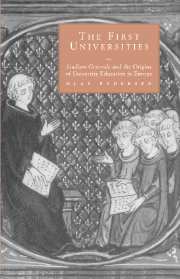Book contents
- Frontmatter
- Contents
- Preface
- Preface to the English edition
- List of abbreviations
- 1 The classical inheritance
- 2 From ancient science to monastic learning
- 3 The Carolingian Renaissance
- 4 The schools of the middle ages
- 5 From school to studium generale
- 6 The battle for the universities
- 7 Structure and form of government
- 8 The material situation
- 9 The road to degrees
- 10 Curricula and intellectual trends
- Index of names
10 - Curricula and intellectual trends
Published online by Cambridge University Press: 03 November 2009
- Frontmatter
- Contents
- Preface
- Preface to the English edition
- List of abbreviations
- 1 The classical inheritance
- 2 From ancient science to monastic learning
- 3 The Carolingian Renaissance
- 4 The schools of the middle ages
- 5 From school to studium generale
- 6 The battle for the universities
- 7 Structure and form of government
- 8 The material situation
- 9 The road to degrees
- 10 Curricula and intellectual trends
- Index of names
Summary
Having considered the structural developments of the university, the material welfare of its scholars, courses of study, and examination arrangements, we are now in a position to face the question of the substance of the teaching itself. It is obviously impossible to devote one chapter alone to any discussion of the very detailed history that learning had in the middle ages as a whole. On the other hand, it is necessary to clarify to some extent some of the principal currents in what intellectual development there was as a result of university activity. This is partly to see what the teaching really contained, partly because the debates and disputes on the curriculum often, with historical hindsight, seem to have been the ideological expression of the power struggle which was going on around the university as an institution and which helped to structure it. The most sensible option is to start with the changes in Paris, which provide the clearest illustration of problems that gave rise to equally intense discussion in other places. To understand the main intellectual movement of the day, furthermore, it would be appropriate to turn to the faculty of artes, home of both philosophy and a number of basic sciences, and therefore in many ways the trendsetter in hotly contested questions of the greatest movement.
The faculty of the ‘liberal arts’ had in many ways a unique position in the university. Firstly, it imparted to all scholars a compulsory fundamental education with a concluding degree that was the necessary precondition of entry to all higher studies.
- Type
- Chapter
- Information
- The First UniversitiesStudium Generale and the Origins of University Education in Europe, pp. 271 - 301Publisher: Cambridge University PressPrint publication year: 1998



